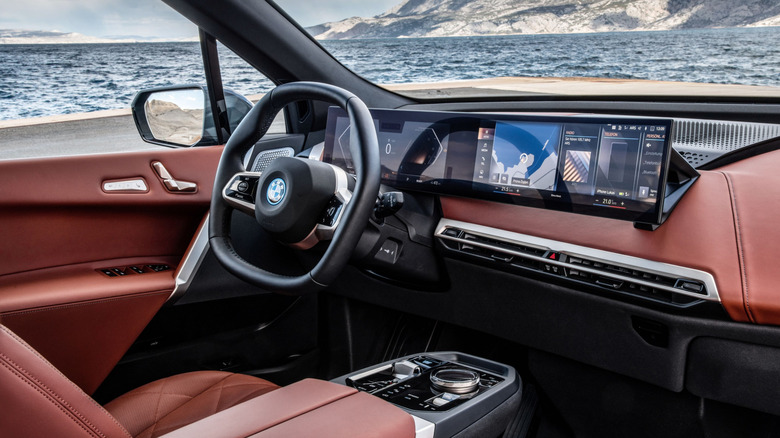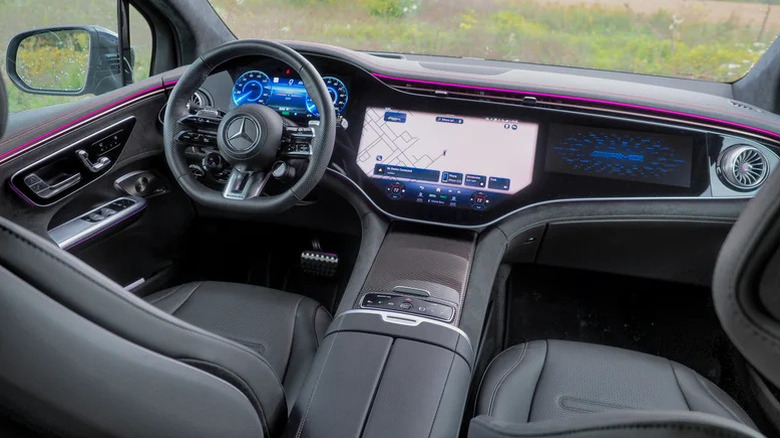Why Some Automakers Are Avoiding Touchscreen Controls For Basic Car Functions
Any driver who's spent time behind the wheel of a modern car will know that touchscreen infotainment displays can be distracting. However, you might not have realized just how unsafe they can be — according to a 2020 study from the UK, using Apple CarPlay or Android Auto while driving can lead to significantly lower response times than being over the country's drink-drive limit or being high on cannabis. Despite that, virtually every modern car now comes with a touchscreen display, and a significant proportion hide most or all of the car's basic functions within touchscreen menus. However, that might begin to change, as new rules from European safety regulators aim to crack down on the excessive use of touchscreens in vehicles.
The reason why automakers continue to rely more heavily on touchscreens rather than buttons and switches is partly financial. It's cheaper to add a touchscreen than develop a different set of buttons and switches for different models, and those savings increase further for larger automakers. Parts sharing between brands is nothing new — many old-school supercars borrowed parts from everyday car models — but a touchscreen panel is particularly versatile.
Why major carmakers prefer touchscreens
In an automaking conglomerate like Stellantis, which owns a wide variety of car brands, the same display that appears in a budget-oriented Fiat could also be reused in a luxurious Maserati without it being immediately obvious. All that's needed is to change the touchscreen's user interface to make the Maserati's menus look a little more upscale. The same display could also potentially be used in a Jeep, an Alfa Romeo, or a Chrysler, with similarly small graphics tweaks needed.
Software is also seen by automakers as a key way to differentiate their car brand from their rivals in a market where electrification is leveling the playing field when it comes to performance. Premium carmakers can no longer rely on having the selling point of a powertrain that's quieter and more powerful than its competition, because electric cars are naturally quiet, and even mainstream brands like Kia now make EVs with over 600 horsepower on tap.
Since the 2010s, mainstream brands have also increasingly offered luxurious top-spec trims with upscale interior materials and longer optional features lists, and so one of the few defining factors separating a mainstream brand from a premium brand is its software. Touchscreens remain the primary way that drivers interact with that software, and so automakers are keen to give them a prominent place in the cabin. However, that prominence is starting to fade, with some automakers now placing more emphasis on other means of control.
The future of in-car touchscreens
Since even budget carmakers now offer large touchscreens with standard Apple CarPlay and Android Auto, the image of touchscreens being a premium, futuristic feature is wearing off. Already, automakers like BMW are placing more emphasis on voice controls, with the brand's latest version of iDrive seeing the capabilities of its Intelligent Personal Assistant expand to cover more in-car functions. However, some carmakers are still convinced that touchscreens are the future: Mercedes-Benz, for example, with its MBUX Hyperscreen. It's included as standard on cars like the Mercedes-AMG EQE SUV, and spans almost the entire width of the car's cabin.
Even if automakers decide that touchscreens are still the most upmarket, futuristic way of interacting with a car, they might not get a choice about including buttons for key functions. Euro NCAP, the European safety institution, has revealed a stricter set of rules that are due to launch in 2026.
They stipulate that automakers must include buttons for certain key functions, like the hazard lights, the horn, and the wipers. If they don't, they won't receive a coveted five-star rating. It remains to be seen how much of an effect this will have on car design, but some automakers are already reversing course. In early 2025, VW confirmed that it was bringing back buttons for all key functions, with its design chief telling Autocar, "they will be in every car that we make from now on [...] It's not a phone: it's a car."


